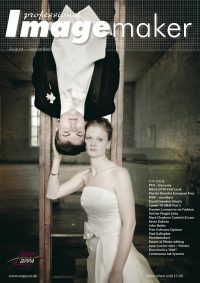articles/Lighting/puttingthedevilintoyourshadows-page3
Lighting For Digital 6 - part 3 of 1 2 3
by Dave Montizambert Published 01/08/2008
Lighting Terrance
Creating appropriate lighting to portray Terrance Toogood as the dastardly villain he is, I enlisted lots of rich shadows. The best way to create lots of shadow form over a subject is to move your lights away from the camera axis, hint: oncamera flash makes for the worst main-light position since it is almost directly on axis with the camera lens. To really get great shadow form on a face, place the main-light to the side, or directly overtop, or underneath the subject. All four of these light positions will skim light across the subject, thus projecting lots of dramatic shadows, visually bringing out the 'character' in a subject.
Now Terrance Toogood is an honest down-to-earth tie-yourheroine-to-a-railway-track sort of character, and so the question of how to best portray his evil attributes didn't take long to figure out; he absolutely needed to be lit from below as though lit from the fires of hell. Not wanting to open up my studio floor to the fires of hell I placed a 3'x4' soft-box on the floor below and to the camera-left side of Terrance, see Image 06 lighting diagram A. The power of this light was adjusted until an incident meter, (pointed dome-directly at this light and held near Terrance's eyes), read exactly the same as the camera's f5.6 @ 1/60th setting.
My choice of background was very dark indeed (somewhere near black in the final image), making it necessary to add separation lights to add backlighting on Terrance to prevent his shoulders from blending into the background too much. There were two lights placed behind Terrance for this purpose, one to his right and one to his left. The separation light on the camera left side to the frame (see Image 06 lighting diagram A) was covered with a frosted acetate gel to even out its hotspots. The power of this light was adjusted until an incident meter, with its dome pointed directly at this light and with its back against Terrance, read one stop darker (f4.0 @ 1/60th) than the camera's f5.6 @ 1/60th setting. To see the effect of this separation light and main-light on Terrance, see Image 07 A.
The second separation light, on the camera-right side of frame, was fitted with a 3'x4' soft-box, see Image 06 lighting diagram B. You are probably wondering why I had one separation light bare and the second separation light fitted with a soft-box? My reason was to ensure that if the second separation light cast any shadows, that these shadows should draw as little attention as possible. To make a shadow less noticeable all you need to do is make its edges softer; softer edges draw less attention than harder edges. Larger light sources see further into shadows, thus eating away at shadow edges rendering them softer. As it turned out, these shadows did not appear with the final poses used, but I felt it was better to be safe than sorry. The positioning of the first separation light relative to Terrance's pose was in no danger of casting unwanted shadows on his neck and so I felt no need to fit it with a soft-box. Using the same metering method as on the first separation light, the second separation light was set to give an incident meter reading of two stops (f2.8 @ 1/60th) below the camera setting. To see the effect of this separation light on Terrance, see Image 07 B.
A fourth strobe head, placed to the right of the camera, was used to fill in the shadows to ensure some detail, see Image 06 lighting diagram C. A frosted acetate gel was added to its front to even out hotspots. The power of this light was adjusted until an incident meter, with its dome pointed directly at this light and with its back against Terrance's face, read two stops darker (f2.8 @ 1/60th) than the camera's f5.6 @ 1/60th setting. To see the effect of this separation light on Terrance, see Image 07 C.
Please Note:
There is more than one page for this Article.
You are currently on page 3 Contact Dave Montizambert
1st Published 01/08/2008
last update 09/12/2022 14:58:24
More Lighting Articles
There are 26 days to get ready for The Society of Photographers Convention and Trade Show at The Novotel London West, Hammersmith ...
which starts on Wednesday 14th January 2026





